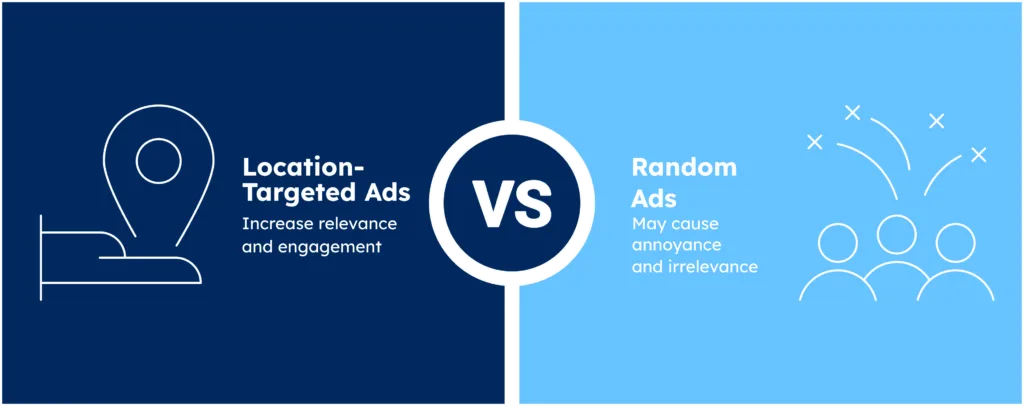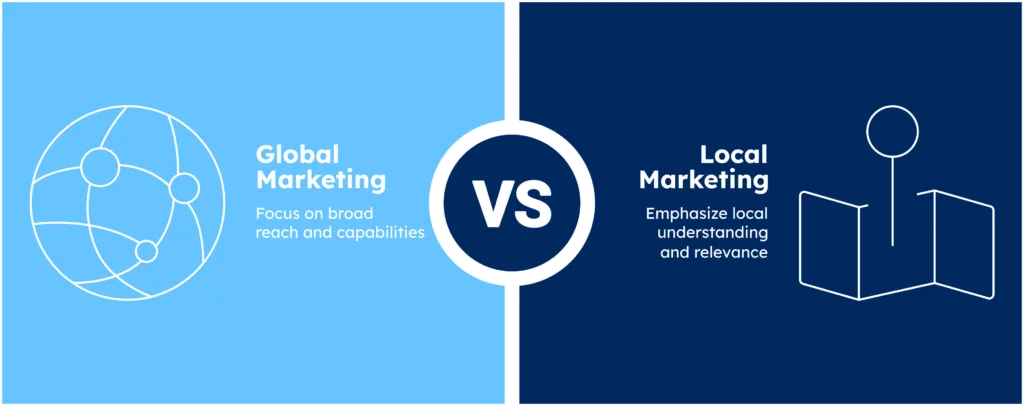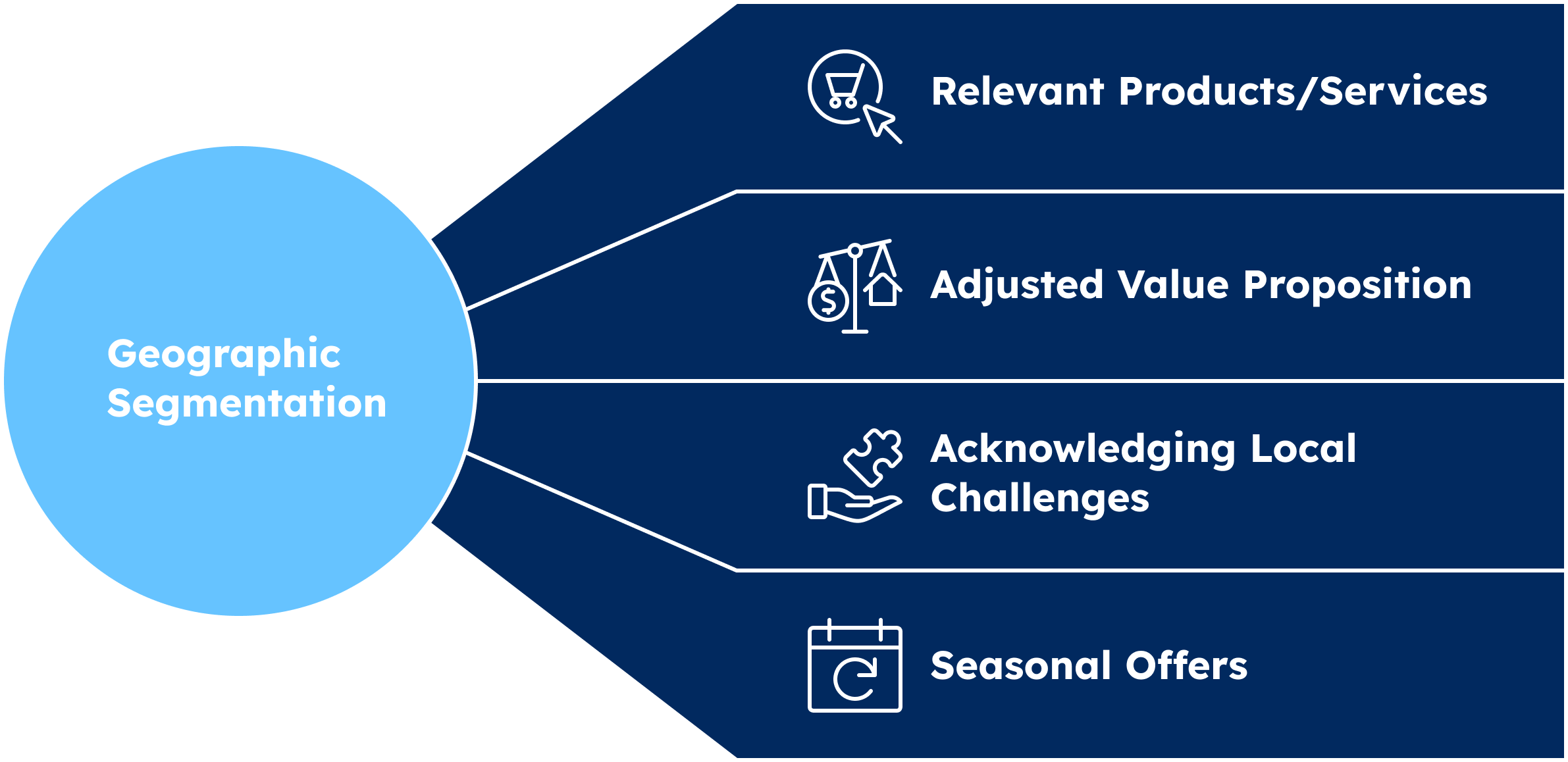Key Takeaways
- Geofencing allows accurate location targeting, delivering ads to users at the right time and place.
- Google Ads’ location targeting lets businesses focus on specific areas, like cities or postal codes.
- Localized ads boost trust and relevance by tailoring messages to particular regions.
- Privacy compliance is key for ensuring consent and transparency in location-based marketing.
Understanding Geofencing and Its Applications
What is Geofencing?
Geofencing creates virtual boundaries. It sends marketing messages when a device crosses them.
At its core, geofencing targets ads to specific areas. These range from broad zones like zip codes to narrow spaces like business districts or store aisles. The technology uses location data from mobile devices through GPS, RFID, Wi-Fi, or cellular data to pinpoint a user’s position.
💡 Use accurate worldwide administrative and zip code boundaries for geofencing. Enhance location-based operations, apps, and maps with our edge-matched polygons. Browse GeoPostcodes datasets for free and download a sample.
The real magic of geofencing is connecting digital ads with physical presence. Instead of hoping to reach interested customers, you can focus exclusively on people who are actually where they need to be to take action.
Benefits of Geofencing in Digital Marketing
Now, let’s talk about the benefits of geofencing in digital marketing. How can geofencing be so helpful and powerful?
Increased Ad Relevance and Engagement
Location-targeted ads perform better because they’re more relevant. When your message acknowledges where someone is, it immediately feels more personal and helpful.
International B2B companies can target messages to the right business zones in each country. Your ads can speak directly to the specific business environment of each location.
The image below highlights the difference between location-targeted ads and random ads.

Cost Efficiency and ROI Optimization
Why waste money showing ads to people who can’t possibly use your services? Location targeting cuts wasted ad spend. It focuses only on regions where your services matter and avoids impressions in irrelevant areas.
Location targeting also boosts ROI. It lowers acquisition costs and puts your budget where it gets results.
Enhanced Local Presence and Trust
Geofencing helps global businesses connect with local audiences, and bridging the gap between global capabilities and local relevance.
Adding location-specific details to your ads creates stronger connections with potential customers. They see that you’re not just some distant entity – you understand their local business environment and needs.
For global companies, showing this local understanding can be a significant differentiator. It transforms you from a “foreign company” to a “global partner with local expertise”.

Implementing Effective Geofencing Strategies
These proven implementation strategies will help you maximize the impact of your location-based marketing campaigns.
How Geofencing Works with Google Ads
Google Ads doesn’t use “geofencing,” but its location targeting works similarly. Here’s how:
- Pick your spots: Define where your ads should appear – countries, cities, postal codes, or custom areas.
- Set your radius: Target users within a specific distance from your business locations.
- Choose your audience: Decide if you want to reach people physically in your target areas or those showing interest in those locations.
- Adjust your bids: Spend more in high-value locations and less in others.
To set it up, go to campaign settings, click “Locations,” and use the “Location options” dropdown to target or exclude areas.
Setting Up Geofencing in Google Ads
To start geofencing in Google Ads, go to campaign settings, click “Locations,” and choose to target people in the area, interested in it, or both.
Use a small radius for physical stores, a wider area for services, and exclude regions you don’t serve.
Match geofencing to real-world behavior. For example, target business districts for consultants and industrial zones for logistics.

Radius Targeting and Bid Adjustments
One of the most interesting features of Google Ads is radius targeting with bid adjustments. It lets you set different bid amounts based on how close someone is to your location. It’s like paying more for prime real estate – the closer they are, the more valuable the impression.
A smart approach might look like this:
- 0-2 miles: +15% bid adjustment (they’re right there!)
- 2-5 miles: +5% bid adjustment (still pretty close)
- 5-10 miles: no adjustment (interested, but less likely to convert immediately)
This strategy recognizes that conversion likelihood often correlates with proximity. You can allocate more of the budget to people who can take immediate action while maintaining visibility with those a bit further away.
Granular Targeting and Location Exclusions
Get specific with your targeting – focus on particular neighborhoods or zip codes instead of broad areas. This accuracy lets you concentrate your efforts on the most promising locations.
Just as important is excluding areas where your target audience isn’t present or where you don’t offer services. It prevents wasted impressions and focuses your budget where it matters most.
For international businesses with complex territories, keep your location targeting updated. Regular reviews ensure your campaigns align with your current service areas and target markets.
Optimizing Ad Content for Location Relevance
Even perfect targeting fails without location-relevant content. Here’s how to create messaging that resonates with local audiences.
Localized Ad Copy and Keywords
Make your ads feel local by including location-specific terms. People pay more attention to ads that mention their location—they feel personal and relevant.
Instead of generic messaging like “Leading Global IT Services,” try “Enterprise IT Solutions for Frankfurt’s Financial District.” These geographic references signal that your message is specifically designed for that location.
Remember that what works in one market might fall flat in another. The business culture in Mexico differs from that in India or Japan, and your messaging should acknowledge these differences.
Key Tips For Localizing Ad Copy
- Include city or district names where appropriate
- Reference local business conditions or challenges
- Adjust your tone to match regional business cultures
- Test different approaches to see what resonates in each location
| generic ad copy | localized ad copy | why it is better |
|---|---|---|
| “Global Supply Chain Solutions” | “Supply Chain Solutions for Rotterdam Port Businesses” | Speaks directly to a specific commercial context |
| “Enterprise Software Implementation” | “Enterprise Software for London’s Financial Services Sector” | Acknowledges industry concentration in the location |
| “International Business Consulting” | “Business Expansion Consulting for Silicon Valley Tech Firms” | Targets a specific business community |
| “Corporate Event Services” | “Corporate Event Management in Singapore’s CBD” | Shows understanding of the local business district |
Location Extensions and Local Context
For physical businesses, location extensions are key—they add your address and contact info to ads, linking digital marketing to your location.
Location extensions help clients find you with directions, confirm your local presence, and contact you via phone or website.
Linking online ads to physical locations makes the customer journey easier. This is especially helpful for global businesses with local branches.
Timing and Context Considerations
Aligning ad delivery: Smart geofencing considers where and when your ads appear. Align your delivery with natural business rhythms in each location.
Analysing location patterns: Office districts can peak during commute and lunch hours, while business hotels are busier in the evenings. Timing helps you reach people when they are most receptive.
Weather: Weather-based targeting lets you change your message based on current conditions. For example, promote one solution during a heat wave and another during a cold snap.
Reinforcing message: After someone engages with a mobile ad, reinforce your message on other devices. B2B decisions often happen across many touchpoints.
The image below summarizes time and context considerations on targeting, messaging, and engagement.

Data Quality and Accuracy Considerations
High-quality location data forms the foundation of successful geofencing. Here’s why accuracy matters and how to ensure it.
Importance of Accurate Location Data
Your geofencing campaigns are only as good as your location data. Even the most clever targeting strategy will fail if it is built on flawed geographic information.
With accurate location data, you can target the business areas where your audience is active. You risk targeting the wrong places or missing intended locations without accurate information.
Location data is challenging because addresses vary, boundaries are unclear, and maps change often.
💡Use accurate location data for effective targeting strategies. Our location data is updated weekly, relying on more than 1,500 sources. Browse GeoPostcodes datasets and download a free sample here.
Even small errors in geofence parameters can tank your campaign performance. If professionals receive promotions for locations too far from their actual business environment, they’ll find it annoying rather than helpful.
| data quality issue | business impact | solution approach |
|---|---|---|
| Outdated Postal Codes | Missed targeting opportunities | Regular database updates |
| Misaligned Boundaries | Targeting the wrong business areas | Accuracy mapping verification |
| Address Format Variations | International targeting issues | Standardized global data |
| Imprecise Coordinates | Ineffective radius targeting | High-accuracy geocoding |
Data Sources and Management
Most companies don’t have the internal resources to manage complex location data effectively. This usually means partnering with specialized providers to maintain accurate geographic information.
Let’s look at how this works in the real world. Eventim, Europe’s first ticketing provider and one of our customers, boosted targeting with postal data and geocoordinates.
This helped calculate the distance between customer addresses and venues. It made event targeting more relevant and marketing more efficient.
The result? More effective targeting, better personalized recommendations, and improved marketing ROI. Eventim’s case shows how good location data makes global marketing work by connecting with the right customers.
Advanced Geofencing Strategies
Advanced geofencing does more than basic targeting. It uses geographic segments, cross-channel tools, and optimization to deliver more relevant marketing. Let’s explore further.
Segmentation and Geo-Specific Offers
Different regions have different needs, so don’t use the same offer everywhere. Segment your audience by location to create offers that match local preferences.
With geographic segmentation, you can focus on products that matter most to each area, adjust your value based on local competition, create promotions tied to specific locations, and tailor offers to seasonal trends.
The result? Higher engagement and better conversion rates compared to universal approaches.
The image below highlights the key points of geographic segmentation.

Cross-Channel Integration
Location-based marketing shouldn’t exist in isolation. After someone engages with your mobile ad in a targeted area, follow up across their other devices and channels.
This approach turns first interactions into lasting customer relationships, not just single clicks.
Effective cross-channel strategies
- Following up mobile engagements with desktop messaging that expands on your value proposition
- Adapting content formats for different devices while maintaining consistent core messaging
- Tracking customer journeys that begin with location triggers but continue through various touchpoints
- Maintaining location awareness in your messaging across all channels
Continuous Optimization and Testing
Successful geofencing requires ongoing monitoring and adjustment. Use tools like Google Ads’ Geo Performance Report to track each location’s performance. Adjust your strategy based on the results.
Key areas to optimize include:
- Analyzing performance across different locations to identify winners and losers
- Testing different radius settings to find the sweet spot for your specific business
- Adjusting location-specific bids based on actual performance data
- A/B testing different messages for various geographic segments
Regular reassessment ensures your targeting stays fresh and responsive to changing business conditions. What worked last quarter might not work today, especially across international markets.
| optimization element | testing approach | measurement metrics |
|---|---|---|
| Geographic Performance | Compare responses by region | Conversion rate, cost per conversion |
| Radius Settings | Test various distance parameters | Engagement rate by distance |
| Bid Adjustments | Vary bids by location value | ROI by location, marginal returns |
| Message Variations | A/B test location-specific content | Click-through rate, conversion by message |
Privacy and Compliance Considerations
As location data becomes more advanced, privacy rules matter more than ever. Following them is not just a legal step—it’s a smart strategy. A clear understanding helps you stay compliant, protect user data, and build client trust.
Navigating Privacy Regulations
Location-based marketing must balance targeting power with privacy rules. It’s not just about legal compliance—it’s about building trust with privacy-conscious business clients.
You must ensure proper consent for location tracking and targeted ads. Be clear about how data is used and protected. Adapt your approach to meet laws in regions like GDPR or CCPA. Only collect the data you truly need for business purposes.
Work with legal experts to stay compliant across all your regions. A strong privacy framework builds trust and drives real engagement.
Building Trust Through Transparency
Beyond compliance, geofencing success depends on trust. Business clients want clear explanations of how their data is used and what they get in return.
Earn that trust by showing the value of location sharing. Give clients control over tracking. Use data only for its intended purpose. Always put privacy first.
Clients are more likely to engage when seeing how their data is used and why it matters. This builds stronger business relationships than vague or unclear approaches.
Conclusion
Geofencing with Google Ads helps you reach potential clients at the right time and place. It makes your marketing more targeted and effective.
However, geofencing only works well with quality location data. Working with providers who offer accurate and complete data ensures your messages reach the right people.
These tools help global businesses stay relevant by combining a wide reach with a local focus.
For more than fifteen years, GeoPostcodes has offered the most extensive global location data, supporting businesses with their geomarketing efforts. Browse GeoPostcodes data and download a free sample here.
FAQ
What is geofencing advertising, and how does it work with Google Ads?
Geofencing advertising uses the Google Ads platform to target users based on their location.
By setting location settings in your Google Ads account, you can create geofencing ads Google that target users in a geofenced area.
This helps businesses aiming to connect with ideal customers in key locations, such as local stores or local events.
How can I ensure my Google Ads are shown to the right audience?
You can use advanced search and geo targeting options in Google Ads to narrow down your audience based on their desired location.
By focusing on local users and related locations, you can ensure your ads are relevant and avoid wasted ad spend by targeting the right personas and desired locations.
How can Google Ads platform help with local marketing?
Google Ads platform offers location-based advertising features, such as setting location permissions to target users’ exact location.
Businesses can significantly enhance their campaigns by showing geofencing marketing ads to users who are in or near local stores, events, or other key locations.
This makes the ads more personalized and relevant.
How do I optimize my Google Ads to target local customers effectively?
To target customers effectively, you can use the search feature in your Google Ads account and adjust your targeting settings to focus on local PPC.
By ensuring users settings allow for location permissions and targeting personas, your ads will be shown to the ideal customers in the geofenced area, improving ad relevance and reducing wasted ad spend.
Can I send personalized notifications to users?
Yes, with Google Ads, you can create a personalized notification based on user behavior, location, and other factors, making your advertising strategy more tailored and effective.
How can I optimize my advertising dollars with Google Ads?
By targeting specific locations, using Google Trends to understand audience behavior, and analyzing historical data, you can optimize your advertising dollars and improve the performance of your campaigns.
How does location affect my Google Ads?
Google Ads considers the user’s location to serve relevant ads, such as showing promotions for nearby retail stores based on the geographic area of the person viewing the ad.
What is geofencing in Google Ads, and how does it work?
Geofencing in Google Ads allows you to target users based on their physical location.
By setting virtual boundaries around specific areas, you can deliver ads to users who enter those areas, making your marketing efforts more focused and timely.




